SEO can be your BEST bet if you’re looking to attract high-quality visitors from search engines like Google.
But… SEO is NOT easy, and it contains MANY tactics.
Some websites use SEO to generate millions of revenue. What kind of strategies do they use?
If you’re looking for real-world SEO examples, this FREE guide is just for you, where you’ll discover;
- Real-world search engine optimization examples
- How authority websites are using the different SEO tactics
- And… how you can use those strategies to improve your own website rankings
Are you curious to find them out? Let’s get into the details.
Table of Contents
6 Best SEO Examples With Real-Life Case Studies

SEO Example 1: Long-Tail Keyword Strategy
The first step to any successful website’s SEO strategy starts with keyword research.
Keyword research is the process of finding relevant keywords that your target audience is using to search for information online.
But don’t target random short-tail keywords, as they have HUGE searches and competition.
No matter your niche, target long-tail keywords.
Long-tail keywords are more specific than common keywords. They also have lower search volume and lesser competition.
For example, the keyword “how to make a website” is a long-tail keyword, while “website” is a more common keyword.
What’s the real-world example of a website using this strategy?
The best SEO example of a website using long-tail keywords is BloggersPassion, a leading digital marketing blog.
By integrating a long-tail keyword strategy within their content, BloggersPassion generates millions of views from Google.
Have a look at the traffic report;
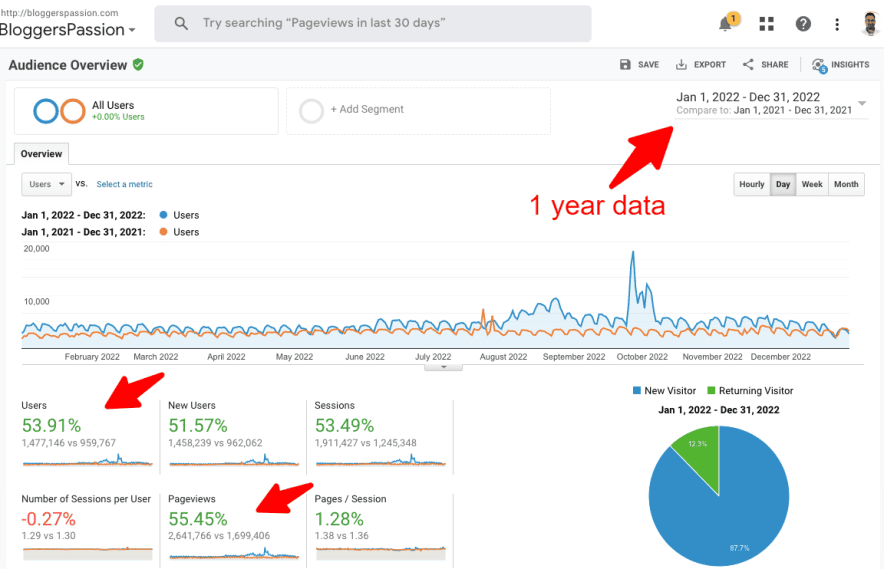
As you can see above, BloggersPassion generated over 2.64 million page views and over 1.47 million visitors in the last year, i.e., 2022.
It is a HUGE jump of 55% in pageviews and users compared to 1.7 million page views and 950K visitors in 2021. The best part? Almost all the traffic comes from Google (free organic traffic!).
BloggersPassion ranks for many long-tail keywords. Here’s an example of a long-tail keyword.
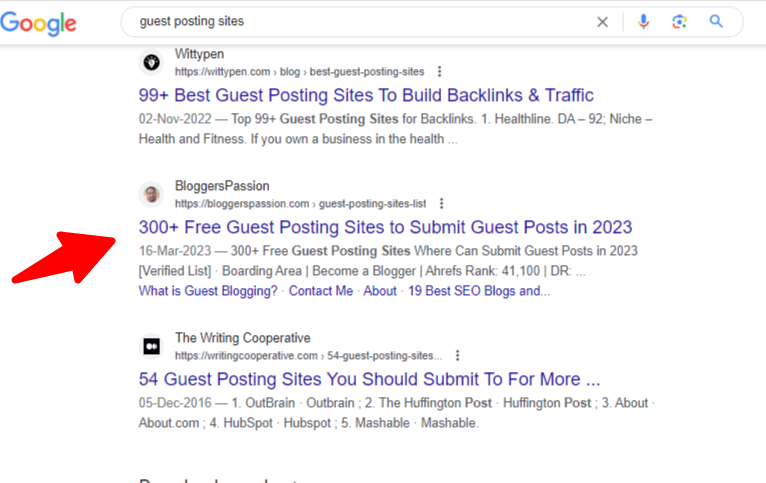
As you can see, the website ranks in the #2 position for a competitive long-tail keyword.
That page alone generated over 37,000 clicks (~12,500 clicks a month) in the last THREE months.
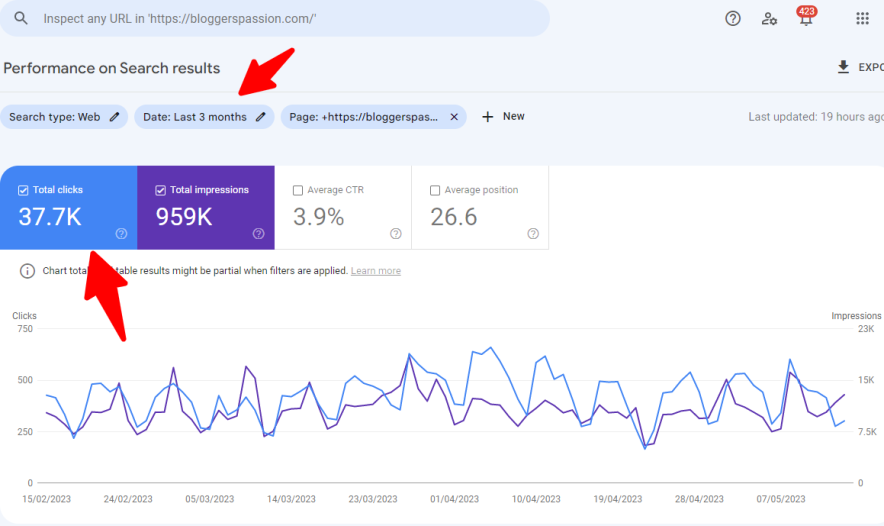
The page also ranks for MANY relevant long-tail keywords.
So if you’re looking to get massive traffic from Google, integrate long-tail keywords in your SEO strategy.
How to Use This Strategy?
Here are a few practical tips to find and integrate long-tail keywords into your website.
Use Google Tools: The simplest (and free) way to find long-tail keywords is to use Google Suggest. When you start typing a keyword or topic into Google, Google Suggest will automatically show you a list of related keywords people are searching for.
You can also use Google’s Related Searches, shown at the bottom of the search results.
A less-known tip is to use Google Search Console to see what keywords people use to find your website. Make sure to find a list of all the long-tail keywords already driving traffic to your website. That way, you can do more research to find relevant keywords to integrate with your website.
Target question words: People often use question words when searching for information on Google. Using question-based keywords can help you attract HIGHLY relevant people looking for information about your products or services.
You can use an FAQ section at the end of every post (or page) by including these question-based keywords.
Use Rank Math: If you’re using WordPress, install an awesome optimization plugin called Rank Math, which helps you optimize your website pages for specific keywords.
Based on how you use those keywords, the Rank Math plugin gives you a score and different colors that represent how well the post is optimized. You can read our Rank Math review for more details on using this plugin like a pro.
SEO Example 2: Link Building Strategy
Backlinks are golden in SEO.
Backlinks from other websites can be considered “positive signals” to Google that your website is trustworthy, which can help you rank higher in search results.
If you’re looking for ONLY one SEO strategy to improve your search rankings, try link building.
“Authoritativeness” is a significant factor in Google search rankings, and backlinks play a huge role as they tell Google you are the authority in your industry.
What’s the real-world example of a website using this strategy?
“Beginner’s Guide to SEO” from Moz is the best example of SEO.
This page ranks for a ton of competitive keywords like SEO, keyword research, technical SEO, etc.
This guide from Moz has generated millions of views since its inception several years ago. It currently generates around 40,000 NEW visitors from search engines.
Have a look at the data from Semrush;
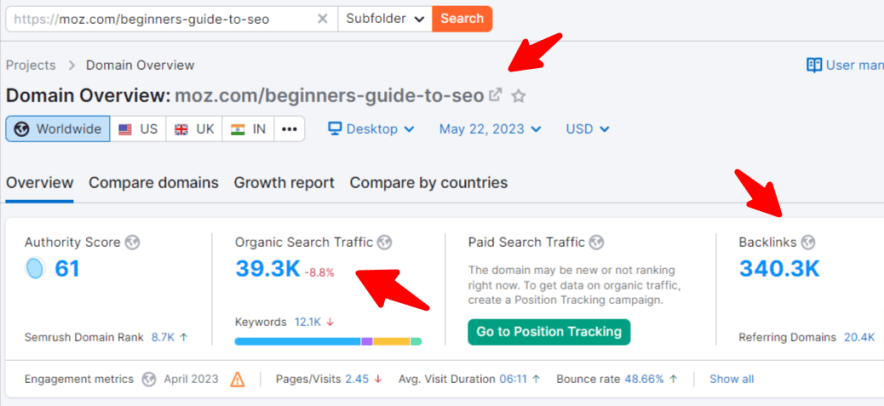
As you can see, this page has nearly 39,3000 visitors/month and over 340,000 backlinks!
340,000 backlinks pointing to a SINGLE web page is an incredible feat, which is worth millions of dollars.
This FREE guide on SEO attracted so many backlinks because it has the BEST content, which is divided into several chapters explaining the important components of SEO.
Have a look;
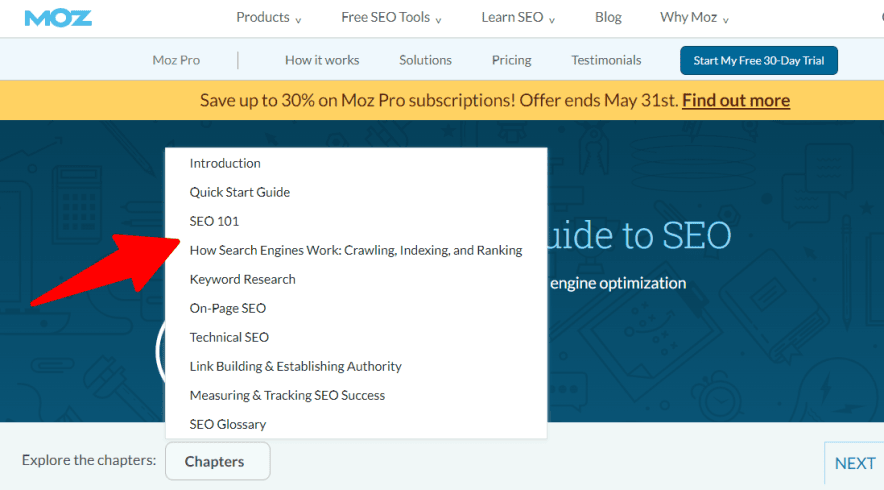
The guide is clearly written for beginners, it satisfies the searchers’ intent, and that’s why it’s performing so well in Google.
How to Use This Strategy?
Here are some easy-to-follow tips to attract quality backlinks to your website in 2023.
Write guest posts: Guest blogging is the evergreen strategy to build links. Find relevant blogging sites that access guest posts and offer quality content to build backlinks. Here’s a huge list of free guest blogging sites if you’re looking for a free resource.
Create 10x content: Moz’s SEO guide ranks #1 on Google for most search terms because of the quality content. If your content is 10x better than your competitors and satisfies the searchers’ intent – it will often rank on top of Google.
Write on Quora: Yes, the links coming from Quora are nofollow. But they’re so useful in building relevant links. Also, many Quora answers rank on the first page of Google search results. It’s a good idea to identify such topics, write helpful answers and link back to your site.
SEO Example 3: Content Marketing Strategy
One of the best ways to improve your website’s SEO is to focus on content marketing.
Content marketing is a widely used strategy in SEO where you create high–quality and informative content to generate links, leads and traffic to your website.
Almost all the websites that rely on SEO traffic depend on “content marketing”.
If used right, content marketing can generate millions of views to your website or business.
What’s the real-world example of a website using this strategy?
HubSpot blog is the finest example of SEO using the content marketing strategy right.
Did you know that HubSpot is generating over 16 MILLION views monthly?
Have a look;
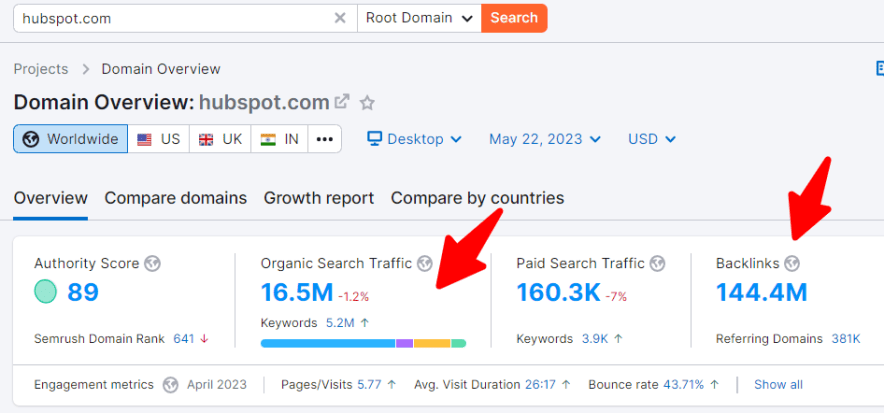
As you can see, HubSpot gets average monthly traffic of over 16.5 million visits and currently has over 144 million backlinks.
Do you know why HubSpot has so many millions of backlinks and so much traffic? Because of its content.
HubSpot ranks for nearly 300,000 keywords, most of which are highly competitive keywords with a HUGE number of searches.
For example, the post “100 most famous quotes of all time” alone sends over 2 million monthly visitors to HubSpot.
Have a look;
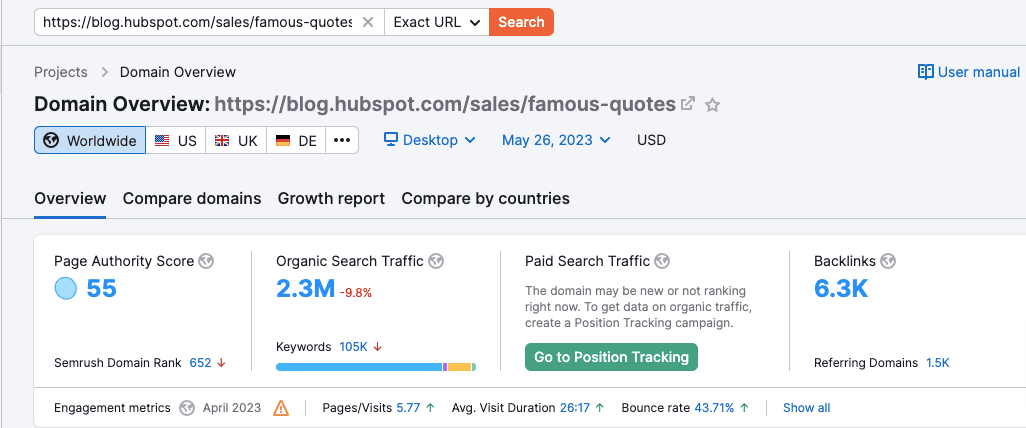
Similarly, HubSpot has several thousands of such posts and guides (most of them are free), continuously sending more traffic and links to the site.
How to Use This Strategy?
Here are some of the effective ways to use content marketing to improve your website’s SEO.
Write in-depth content: HubSpot ranks #1 for most topics primarily because they write in-depth guides. In the above example, they published a listicle post sharing 100 quotes (not just 10 or 15 quotes). In-depth content still works best for most industries.
Stick to evergreen content: If you’ve decided to invest money or time in content creation, focus on finding “evergreen topics” (cornerstone content) that will stay relevant even after five years.
In case you’re curious, evergreen (or timeless) content is content that stays relevant for a long period of time. It is not related to current events or trends and can be shared by people years after it was first published.
Repurpose your content: HubSpot also uses the strategy of repurposing its content. They create one guide and turn it into different types, including eBooks, checklists, guides, videos, etc.
For more information, read our content marketing strategy guide, where you can find practical advice with lots of examples.
Create lead magnets with your content: If you’ve read any free guides or articles on the HubSpot blog, you’ll often notice that they use “lead magnets” such as free checklists, eBooks, etc to collect emails from their audience.
That’s a smart strategy to build an audience who’s interested in your products or content. HubSpot has millions of email subscribers and whenever they publish new content, they blast out their lists with emails, which instantly generate a ton of views.
SEO Example 4: Content Refresh Strategy
Content refresh simply means updating your existing content to improve its quality and freshness.
Whether you know it or not, search engines like Google take “content freshness” into consideration while ranking a website.
That’s why most SEO experts often update their traffic-generating pages and publish with the latest dates to improve their organic clicks.
Some of the BIGGEST benefits to content refreshing include the following.
- Improve your search rankings, as Google rewards websites with fresh, up-to-date content.
- Increased visibility to your existing content. People often share the latest and relevant content on social media. That’s what they often link to.
- Updated content is more helpful to your website users, which can ultimately help with better conversions.
What’s the real-world example of a website using this strategy?
Shopify’s “Secrets to Making Money Online” guide is one of the best examples.
This guide was first published on January 2021 and generated only 1900 visitors in its first month.
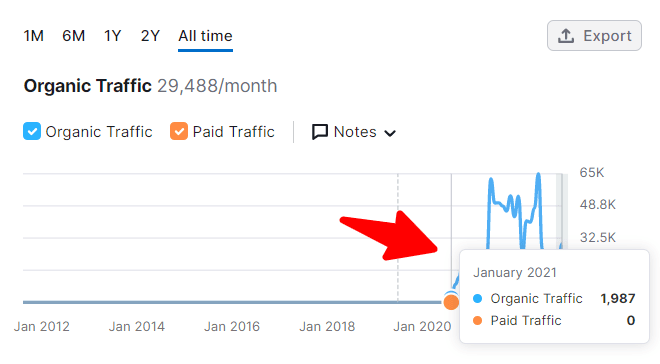
Later, the content marketing team at Shopify updated the guide multiple times.
Fast forward to 2023, this guide generates nearly 30K monthly visits.
Adam Rogers, a senior Content Marketing Manager at Shopify, mentioned, “to maintain rankings, we had to remove outdated content and list more ideas.”
According to Semrush data, this page alone from Shopify attracts nearly 30,000 new visitors every month, meaning around 1000 visitors daily!
Have a look at the data;
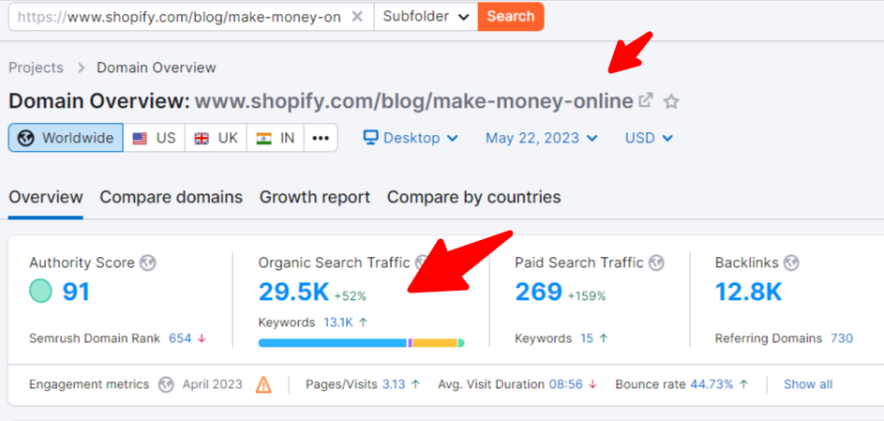
See that? This one page alone has attracted over 12,800 backlinks from various sources online.
The bottom line? The content refresh strategy works like a charm in terms of generating more search traffic and backlinks to your website.
How to Use This Strategy?
Here are a few PROVEN ways to use the “content refresh” SEO strategy to boost your rankings.
Focus on quality over quantity: First of all, identify a list of the top 10 to 15 high-traffic blog posts (or pages) on your website. You can use Google Analytics and Search Console to get that data.
It’s better to refresh a few high-quality pages than to refresh hundreds of low-quality blog posts.
Make sure the topic is still relevant: Before you refresh your existing content, make sure the topic is still relevant to your target audience. There’s no point in updating a blog post or page if it has an outdated topic that has no searches. For example, if you’re running a marketing blog, there’s no reason to update a post on “increasing RSS subscribers” as it’s outdated.
Use the right keywords: When refreshing your old content, research all the related keywords around that topic.
You can attract new visitors from search engines like Google by using the right keywords. Don’t overoptimize your posts but use relevant keywords naturally throughout the content.
Tweak the existing content: Update the title tag and meta description to make your metadata appealing. Add new images to make the content more appealing and link to other relevant blog posts on your website.
While updating the existing posts, keep your target audience in mind and know the “intent” behind each keyword. Spend as much time (or money) as you can promote the old content to get the word out.
SEO Example 5: Make Outreach a Priority
Are you looking for an effective way to build high-quality backlinks to your website?
Then, you should try SEO outreach.
SEO outreach is a proven link building strategy that helps you build relevant links and improve your website’s organic rankings.
But… you need to have a few things on your website to make outreach work, which includes;
- High-quality content, which is created specifically to attract links
- Identifying key influencers in your industry
- Having access to the right tools for link prospecting and more
Many businesses give #1 priority to SEO outreach, and they literally spend millions of dollars each year.
What’s the real-world example of a website using this strategy?
If you’ve been doing SEO for a while, you might have probably heard of Brian Dean (or) Backlinko.
Backlinko.com is an authoritative website in the SEO industry where you can learn exclusive SEO tips to grow your search traffic.
Outreach is a major growth factor for Backlinko’s success.
Brian Dean mentions spending only 20% of his time on content creation and the other 80% on promoting it.
That’s why most of his content ranks at the top of Google search results, generating millions of visitors yearly.
The #1 strategy Brian Dean uses to promote his content is “blogger outreach”.
Here’s what he does: he creates 10x engaging content on ANY topic he picks, then he shares it with industry thought leaders who have already posted similar content on their social networks.
Most influencers often promote Brian’s content because of the “quality”.
Backlinko’s “Google’s Ranking Factors” is the best example of his content, where he relied MOSTLY on SEO outreach to build links.
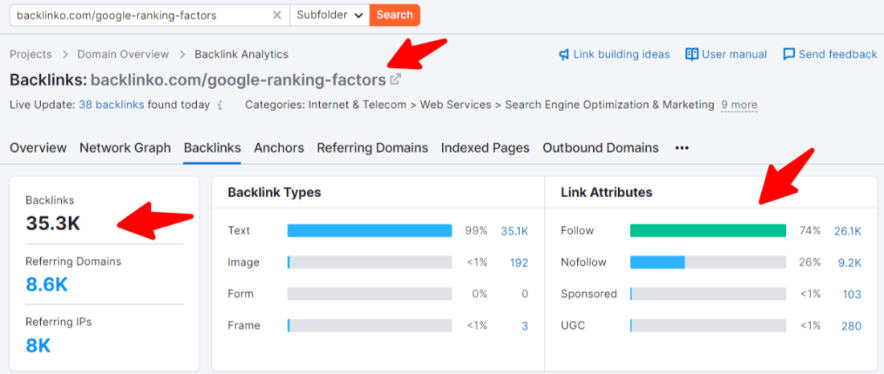
See that? This article generated over 35,000 backlinks. Just imagine over 35K links pointing to ONE web page. Google will obviously rank it on top of search results, and the post is currently ranking #1 or #2 for most terms related to “ranking factors”.
Also, the same guide fetched over 47,000 social shares just from his own website.
Have a look;
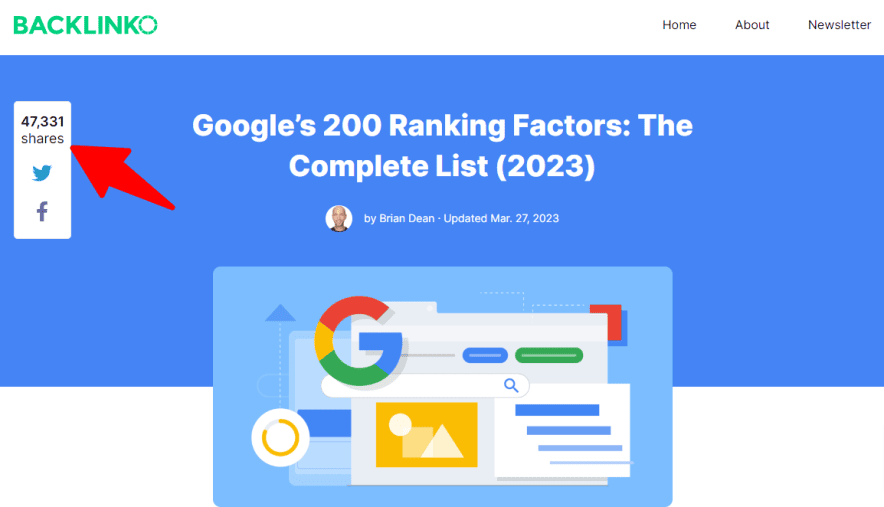
Thanks to his SEO outreach skills, Brian was able to generate so much buzz with his content on social networks.
How to Use This Strategy?
Here are some of the PROVEN ways to get the most out of outreach strategy for SEO.
Make a list: Before you begin the SEO outreach, create a list of 20 to 30 influencers in your industry. You can use tools like Ahrefs or Semrush to help you with your research.
Provide value: Don’t just ask for a link while reaching out. It does not work. Instead, offer them something of value in return, such as a high-quality guest blog post, a case study, etc. It’s also a good idea to build relationships with the website owners before you ask for help.
Create high-quality visuals: One of the simplest ways to get links is to create appealing visuals such as infographics, charts, etc so you can ask other bloggers to use them and link to your website.
If you’re looking for more tips, check out our free guide on blogger outreach strategy to find more details.
SEO Example 6: Search Intent is the King
Search intent (also known as user intent & keyword intent), is the reason why someone searches for something on the internet. It’s about what the person wants to do with their search, like finding answers, visiting a website, buying something, or learning about a topic.
Search engines, like Google, want to show users relevant results. So, understanding what people are looking for when they search is important for how well you rank in search results.
Google has worked hard to understand what users mean when they search. You can see this in Google’s guidelines for assessing search quality, which has a section about understanding different types of user intent. To rank well on Google, your web pages need to match what people want when they search for specific keywords.
Which Website has Implemented this SEO strategy?
Our website’s web page saw better rankings after we adjusted it to match the user’s search intent. This page used to underperform because it contained content unrelated to what users were searching for.
Let me give you a proof:
“Hostinger coupon code” was one of our posts that didn’t rank on the first page until last February because the intent of our post was informational (blog-based). But we realized this mistake and changed its intent to commercial.
We started using coupon codes instead of blog-based info because if you search for the query “Hostinger coupon code,” as per user intent, they are looking for coupon codes that were not in our post before. So just by changing user intent, our post’s traffic has improved by more than 1000%. The traffic that used to be 5-6 per day is now over 100.

If your website also has posts with content that doesn’t align with user intent, you can implement this SEO strategy to improve your rankings.
Let me explain how you can correctly figure out user intent.
How can this SEO strategy be put into action?
To uncover user intent behind a search query, one of the simplest methods is to search the query on Google. Upon reviewing the search results, you can classify the keyword into one of three primary types: Navigational, Transactional, or Informational.
For example, if you input “Buy Backlinks” into the search bar, you’ll notice results displaying websites selling backlinks (transactional) and websites reviewing platforms that sell backlinks (informational). This reveals that there could be two potential intents behind this search query.
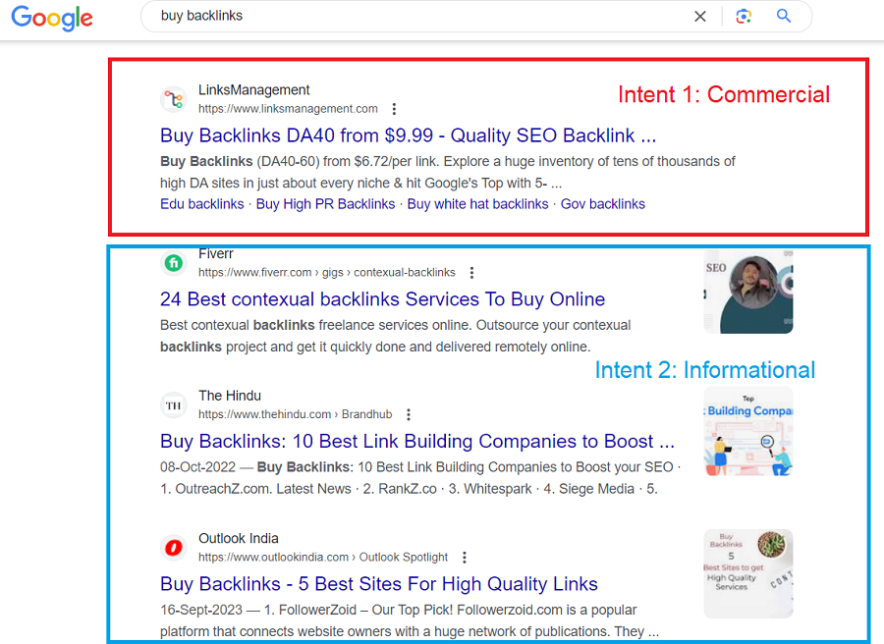
I understand that manually analyzing user intent can sometimes be confusing.
However, if you have an SEO tool like Semrush, you can quickly determine the correct user intent with just one click.
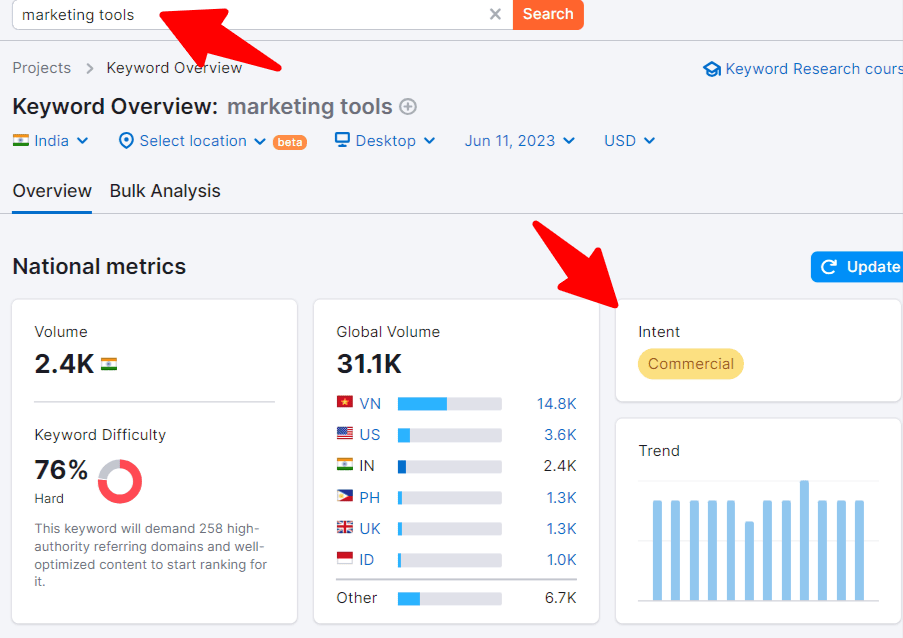
Semrush provides you with incredible SEO features that allow you to complete common SEO tasks in seconds, saving you valuable time. If you wish, you can test this feature by taking advantage of Semrush’s 14-day free trial.
Bad SEO Examples:
Did you ever think that all SEO strategies and case studies bring only good results? Well, some SEO examples show that using the wrong strategy can actually harm your SEO rankings. In this section, we will cover some such negative SEO examples.
1.) Not Following Google Link Spam Guidelines:

A few days back, we made changes to our website’s footer by adding additional commercial links in an attempt to improve SEO. However, this action violated one of Google’s spam policy factors, which involves widely distributed links in website footers.
When our site’s overall traffic started to decline, we decided to undo this practice. This strategy used to work until last year, but it seems that Google has tightened its spam policies.
We’ll keep adding more bad SEO examples to this section from time to time, so stay tuned.
FAQs | Best SEO Examples
Here are some frequently asked questions about SEO and search engine optimization examples.
SEO stands for Search Engine Optimization. SEO is the process of improving the ranking of a website in search results by using various tactics like keyword research, link building, content creation, etc.
Some of the common types of examples of SEO marketing include;
– On-page optimization
– Link building
– Long-tail keyword strategy and content marketing
SEO’s ultimate goal is to improve a website’s overall visibility and search rankings. It can generate free visitors, leads, and sales to a website or business.
Here are some of the top companies that use SEO to improve sales.
– HubSpot
– Semrush
– Shopify
If your business wants free traffic and leads from Google, it definitely needs SEO. But PPC (paid search ads) might be your best option if you’re looking for quick results.
SEO is necessary for small businesses as long as websites and search engines like Google, Bing, Yahoo, etc. exist. People will be looking for information online before making a purchase. Here’s where SEO comes in handy.
The top Google ranking factors are;
– Your website’s content
– User experience
– Backlinks (as they directly represent the authoritativeness of a website)
Few More FREE Related Resources:
- SEO Friendly Titles: 8 Best Practices With Examples
- Step By Step SEO Tutorial For Beginners in 2023
- SEO for eCommerce Websites 2023
- Blog Post Length: How Long Should a Blog Post Be?
- Future of SEO 2023: 5 Trends that Will Impact Your Business
- What is E-A-T in SEO? How to Optimize Your Website for It?
- Best Website Ideas for Beginners to Start in 2023
- Homepage SEO: A Complete Guide for Beginners
- Top SEO Trends to Know to Boost Your Rankings in 2023
Final thoughts on search engine optimization examples
SEO is still a major source for most websites to generate traffic and revenue.
But the game of SEO is changing, as search engines like Google make thousands of changes to their algorithms each year. That’s why you need to identify what works and implement those strategies.
What are your thoughts on the SEO examples shared above? Did you find this case study helpful? Have any questions? Let us know your thoughts in the comments.



![Step by Step SEO Tutorial 2023 for Beginners [Our 12 yrs traffic stats included]](webp/seo-tutorial-for-beginners-2.webp)